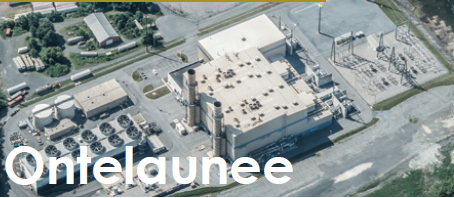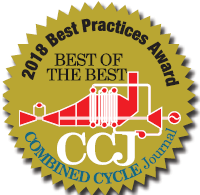
Recognized for its Best Practice in Performance Improvement
 Water-wash program gives year-round benefit
Water-wash program gives year-round benefit
A new powerplant with no leaking valves and latest-technology equipment generally doesn’t have to be concerned with losing a few points in its heat rate. Add 15 years of operation and that measurement of plant efficiency takes on a whole new meaning. One of the best ways to keep efficiency as high as possible is to maintain the equipment in the best possible operating condition. For gas turbines, that includes a clean compressor.
Like many other plants powered by gas turbines, Ontelaunee Energy Facility, a 2 × 1 F-class combined cycle owned/operated by Dynegy Inc and managed by PM John Goodman, relies on springtime offline water washes to regain compressor efficiency losses. Offline water washes would show remarkable improvement, but as the turbine ran, the compressor would foul and efficiency would slowly creep downward. Determined to find a way to maximize efficiency longer, Ontelaunee began an online water-wash program.
Initially, the program focused on performing water-only rinses three times a week. Result: Efficiency did not decrease as quickly as before. However, once temperatures began to drop in the fall, the water-wash skid was winterized and remained out of service unit the annual offline wash in spring.
In 2017, Ontelaunee decided to make the online water wash program more robust. This included performing online water rinses daily and online soap washes weekly. Both the rinses and washes were conducted in accordance with OEM recommendations. This compressor cleaning program gave good results, efficiency remaining close to what is was immediately after an offline water wash.
However, staff was concerned about the wintertime, when ambient temperatures would drop below the suggested minimum washing temperature. The OEM’s water-wash procedure has a recommendation for using anti-freeze—either ethylene glycol or propylene glycol. But past experience with glycol-based anti-freeze was that it had a negative effect on gas-turbine emissions. Not wanting to risk an emissions exceedance, the plant sought a different solution.
Ontelaunee planned to install an inlet bleed heat (IBH) system to combat air-filter clogging which could occur during snow events. With the PJM implementing a “capacity performance” segment, penalties for forced outages and derates attributed to filter clogging became a major financial concern. In 2016-2017, the IBH system, designed by PSM, was installed. The immediate benefit of preventing filter clogging was realized, but staff saw a possible additional opportunity for performance improvement.

Staff reasoned that if the IBH system could raise inlet scroll temperatures to prevent bellmouth and Row 2 compressor-blade icing, it might increase the air temperature enough to continue online water rinses in cold weather. It did. Today, anytime the ambient temperature is above 35F, IBH can raise the inlet temperature enough to permit an online water rinse. This allows the water-wash program to continue year-round, enabling the plant to maintain a competitive heat rate.









